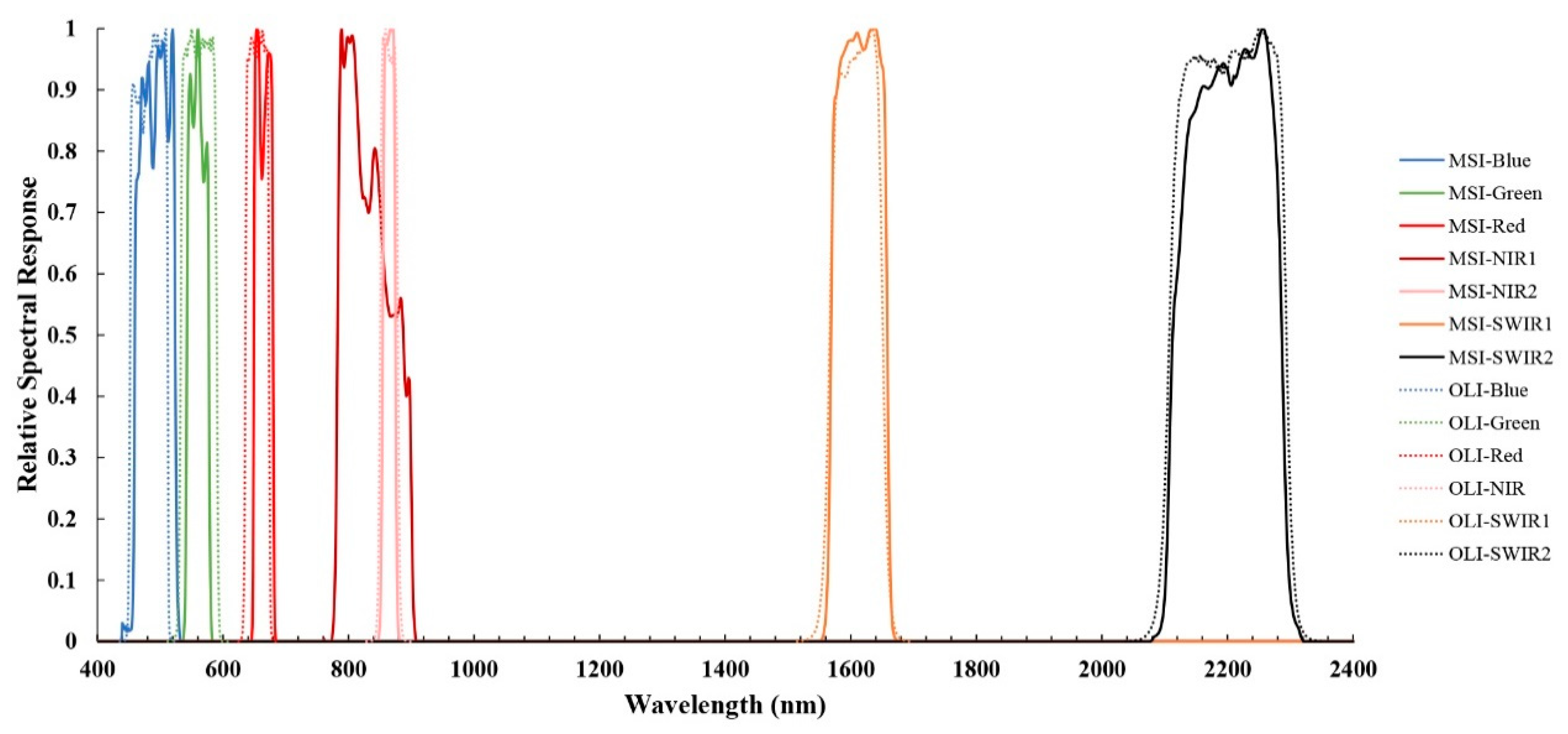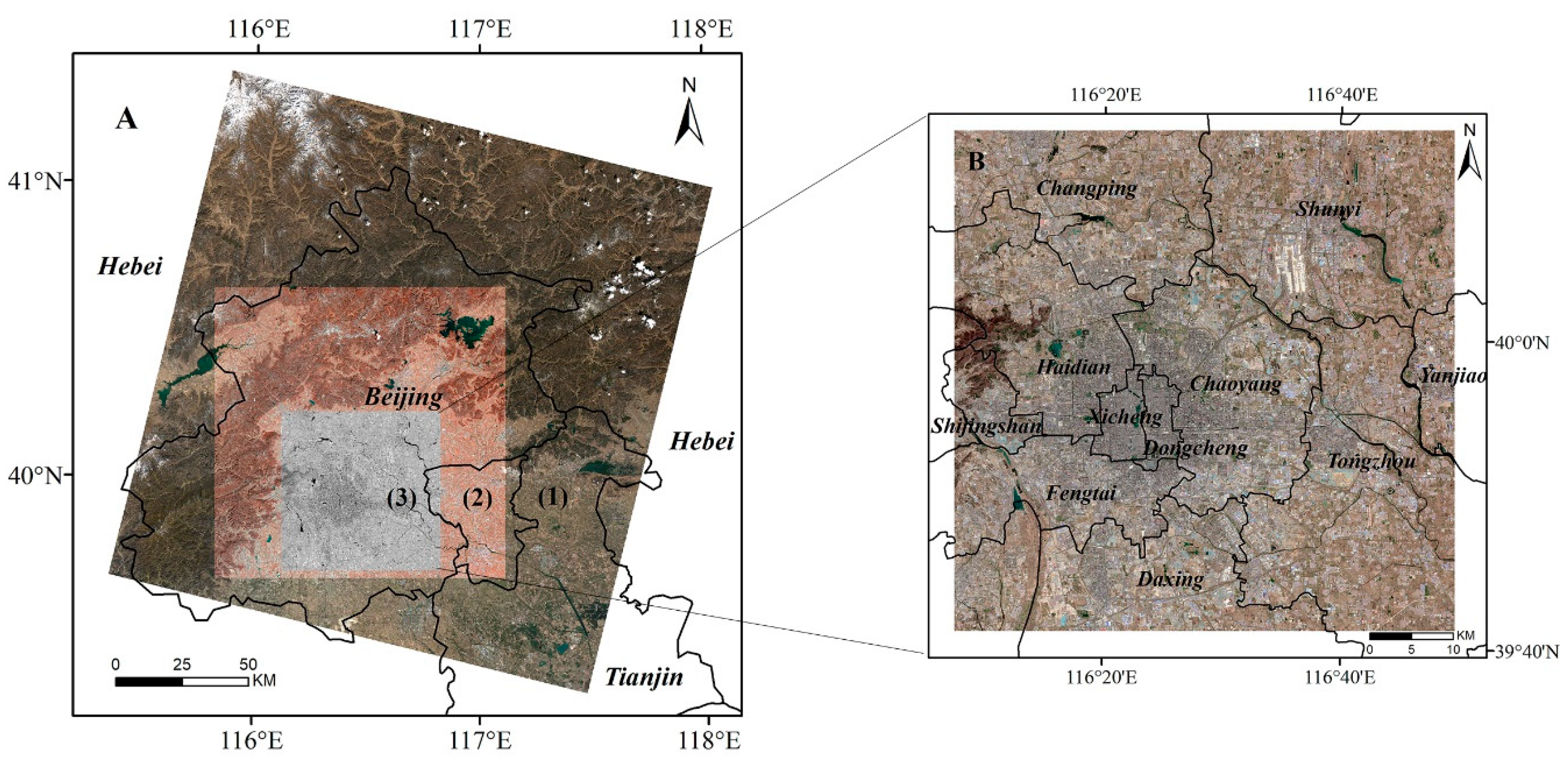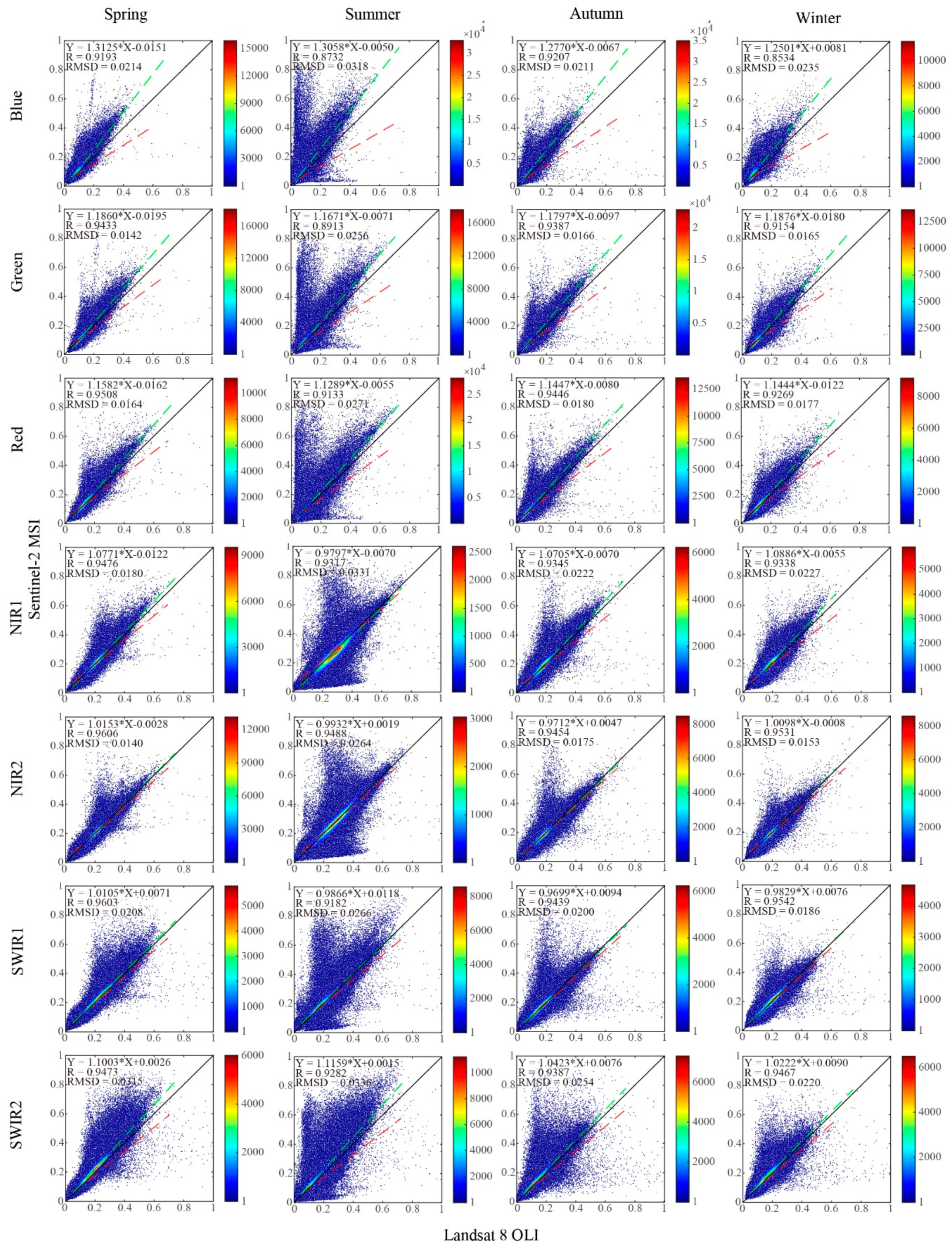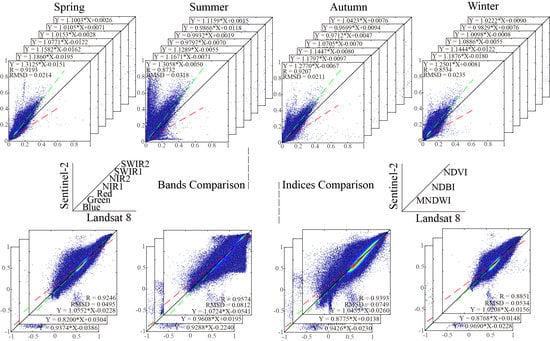Preliminary Evaluation of the Consistency of Landsat 8 and Sentinel-2 Time Series Products in An Urban Area—An Example in Beijing, China
Abstract
1. Introduction
2. Materials and Methods
2.1. Data Source
2.2. Study Area
2.3. Data Pre-processing
2.4. Statistical Analysis
3. Results
3.1. Comparison Between Landsat 8 and Sentinel-2
3.2. NDVI, NDBI, and MNDWI Comparison
3.3. Build-up Area Identification by IBI Between OLI and MSI
4. Discussion
4.1. Analysis on the Consistency of Bands and Indices Between OLI and MSI
4.2. Comparison of Roughly Built-up Area Identification Between OLI and MSI and Future Work
5. Conclusions
Author Contributions
Funding
Conflicts of Interest
References
- Lahariya, C. The State of the World Population 2007: Unleashing the potential of urban growth. Indian Pediatr. 2008, 45, 481–482. [Google Scholar] [PubMed]
- Xu, H. A new index for delineating built-up land features in satellite imagery. Int. J. Remote Sens. 2008, 29, 4269–4276. [Google Scholar] [CrossRef]
- Gong, P.; Liang, S.; Carlton, E.J.; Jiang, Q.; Wu, J.; Wang, L.; Remais, J.V. Urbanisation and health in China. Lancet 2012, 379, 843–852. [Google Scholar] [CrossRef]
- Wei, C.; Zhang, Y.; Pengwang, C.; Gao, W. Evaluation of urbanization dynamics and its impacts on surface heat islands: A case study of Beijing, China. Remote Sens. 2017, 9, 453. [Google Scholar]
- Kaufmann, R.K.; Seto, K.C.; Schneider, A.; Liu, Z.; Zhou, L.; Wang, W. Climate response to rapid urban growth: Evidence of a human-induced precipitation deficit. J. Clim. 2007, 20, 2299–2306. [Google Scholar] [CrossRef]
- Li, X.; Zhou, Y.; Asrar, G.R.; Mao, J.; Li, X.; Li, W. Response of vegetation phenology to urbanization in the conterminous United States. Glob. Chang. Biol. 2017, 23, 2818–2830. [Google Scholar] [CrossRef]
- Yao, R.; Wang, L.; Huang, X.; Guo, X.; Niu, Z.; Liu, H. Investigation of urbanization effects on land surface phenology in Northeast China during 2001–2015. Remote Sens. 2017, 9, 66. [Google Scholar] [CrossRef]
- Zhang, Q.; Seto, K.C. Can night-time light data identify typologies of urbanization? A global assessment of successes and failures. Remote Sens. 2013, 5, 3476–3494. [Google Scholar] [CrossRef]
- Xie, Y.; Weng, Q. Spatiotemporally enhancing time-series DMSP/OLS nighttime light imagery for assessing large-scale urban dynamics. ISPRS J. Photogramm. Remote Sens. 2017, 128, 1–15. [Google Scholar] [CrossRef]
- Zhou, Y.; Yang, G.; Wang, S.; Wang, L.; Wang, F.; Liu, X. A new index for mapping built-up and bare land areas from Landsat-8 OLI data. Remote Sens. Lett. 2014, 5, 862–871. [Google Scholar] [CrossRef]
- Zhang, H.; Lin, H.; Wang, Y. A new scheme for urban impervious surface classification from SAR images. ISPRS J. Photogramm. Remote Sens. 2018, 139, 103–118. [Google Scholar] [CrossRef]
- Solari, L.; Ciampalini, A.; Raspini, F.; Bianchini, S.; Moretti, S. PSInSAR analysis in the pisa urban area (Italy): A case study of subsidence related to stratigraphical factors and urbanization. Remote Sens. 2016, 8, 120. [Google Scholar] [CrossRef]
- Li, X.; Zhou, Y.; Zhu, Z.; Liang, L.; Yu, B.; Cao, W. Mapping annual urban dynamics (1985–2015) using time series of Landsat data. Remote Sens. Environ. 2018, 216, 674–683. [Google Scholar] [CrossRef]
- Cao, X.; Chen, J.; Imura, H.; Higashi, O. A SVM-based method to extract urban areas from DMSP-OLS and SPOT VGT data. Remote Sens. Environ. 2009, 113, 2205–2209. [Google Scholar] [CrossRef]
- Small, C. High spatial resolution spectral mixture analysis of urban reflectance. Remote Sens. Environ. 2003, 88, 170–186. [Google Scholar] [CrossRef]
- Roy, D.P.; Wulder, M.A.; Loveland, T.R.; Woodcock, C.E.; Allen, R.G.; Anderson, M.C.; Helder, D.; Irons, J.R.; Johnson, D.M.; Kennedy, R.; et al. Landsat-8: Science and product vision for terrestrial global change research. Remote Sens. Environ. 2014, 145, 154–172. [Google Scholar] [CrossRef]
- Drusch, M.; Del Bello, U.; Carlier, S.; Colin, O.; Fernandez, V.; Gascon, F.; Hoersch, B.; Isola, C.; Laberinti, P.; Martimort, P.; et al. Sentinel-2: ESA’s Optical High-Resolution Mission for GMES Operational Services. Remote Sens. Environ. 2012, 120, 25–36. [Google Scholar] [CrossRef]
- Li, J.; Roy, D.P. A global analysis of Sentinel-2a, Sentinel-2b and Landsat-8 data revisit intervals and implications for terrestrial monitoring. Remote Sens. 2017, 9, 902. [Google Scholar]
- Xiong, J.; Thenkabail, P.; Tilton, J.; Gumma, M.; Teluguntla, P.; Oliphant, A.; Congalton, R.; Yadav, K.; Gorelick, N. Nominal 30-m Cropland Extent Map of Continental Africa by Integrating Pixel-Based and Object-Based Algorithms Using Sentinel-2 and Landsat-8 Data on Google Earth Engine. Remote Sens. 2017, 9, 1065. [Google Scholar] [CrossRef]
- Inglada, J.; Arias, M.; Tardy, B.; Hagolle, O.; Valero, S.; Morin, D.; Dedieu, G.; Sepulcre, G.; Bontemps, S.; Defourny, P.; et al. Assessment of an operational system for crop type map production using high temporal and spatial resolution satellite optical imagery. Remote Sens. 2015, 7, 12356–12379. [Google Scholar] [CrossRef]
- Brezonik, P.L.; Olmanson, L.G.; Finlay, J.C.; Bauer, M.E. Factors affecting the measurement of CDOM by remote sensing of optically complex inland waters. Remote Sens. Environ. 2015, 157, 199–215. [Google Scholar] [CrossRef]
- Pahlevan, N.; Chittimalli, S.K.; Balasubramanian, S.V.; Vellucci, V. Sentinel-2/Landsat-8 product consistency and implications for monitoring aquatic systems. Remote Sens. Environ. 2019, 220, 19–29. [Google Scholar] [CrossRef]
- Novelli, A.; Aguilar, M.A.; Nemmaoui, A.; Aguilar, F.J.; Tarantino, E. Performance evaluation of object based greenhouse detection from Sentinel-2 MSI and Landsat 8 OLI data: A case study from Almería (Spain). Int. J. Appl. Earth Obs. Geoinf. 2016, 52, 403–411. [Google Scholar] [CrossRef]
- Mandanici, E.; Bitelli, G. Preliminary comparison of sentinel-2 and landsat 8 imagery for a combined use. Remote Sens. 2016, 8, 1014. [Google Scholar] [CrossRef]
- Roy, D.P.; Kovalskyy, V.; Zhang, H.K.; Vermote, E.F.; Yan, L.; Kumar, S.S.; Egorov, A. Characterization of Landsat-7 to Landsat-8 reflective wavelength and normalized difference vegetation index continuity. Remote Sens. Environ. 2016, 185, 57–70. [Google Scholar] [CrossRef]
- Chastain, R.; Housman, I.; Goldstein, J.; Finco, M. Empirical cross sensor comparison of Sentinel-2A and 2B MSI, Landsat-8 OLI, and Landsat-7 ETM+ top of atmosphere spectral characteristics over the conterminous United States. Remote Sens. Environ. 2019, 221, 274–285. [Google Scholar] [CrossRef]
- Flood, N. Comparing Sentinel-2A and Landsat 7 and 8 using surface reflectance over Australia. Remote Sens. 2017, 9, 659. [Google Scholar] [CrossRef]
- Lessio, A.; Fissore, V.; Borgogno-Mondino, E. Preliminary tests and results concerning integration of sentinel-2 and Landsat-8 OLI for crop monitoring. J. Imaging 2017, 3, 49. [Google Scholar] [CrossRef]
- European Space Agency. Available online: https://sentinel.esa.int/web/sentinel/technical-guides/sentinel-2-msi/level-1c/algorithm (accessed on 8 April 2019).
- National Aeronautics and Space Administration. Available online: http://landsat.gsfc.nasa.gov/wp-content/uploads/2014/09/Ball_BA_RSR.v1.2.xlsx (accessed on 28 November 2018).
- Lefebvre, A.; Sannier, C.; Corpetti, T. Monitoring urban areas with Sentinel-2A data: Application to the update of the Copernicus High Resolution Layer Imperviousness Degree. Remote Sens. 2016, 8, 606. [Google Scholar] [CrossRef]
- Arekhi, M.; Goksel, C.; Balik Sanli, F.; Senel, G. Comparative Evaluation of the Spectral and Spatial Consistency of Sentinel-2 and Landsat-8 OLI Data for Igneada Longos Forest. ISPRS Int. J. Geo-Inf. 2019, 8, 56. [Google Scholar] [CrossRef]
- Chen, J.; Jönsson, P.; Tamura, M.; Gu, Z.; Matsushita, B.; Eklundh, L. A simple method for reconstructing a high-quality NDVI time-series data set based on the Savitzky-Golay filter. Remote Sens. Environ. 2004, 91, 332–344. [Google Scholar] [CrossRef]
- Xu, Y.; Yu, L.; Zhao, F.R.; Cai, X.; Zhao, J.; Lu, H.; Gong, P. Tracking annual cropland changes from 1984 to 2016 using time-series Landsat images with a change-detection and post-classification approach: Experiments from three sites in Africa. Remote Sens. Environ. 2018, 218, 13–31. [Google Scholar] [CrossRef]
- Irons, J.R.; Dwyer, J.L.; Barsi, J.A. The next Landsat satellite: The Landsat Data Continuity Mission. Remote Sens. Environ. 2012, 122, 11–21. [Google Scholar] [CrossRef]
- Lu, C.; Fan, L. Winter wheat yield potentials and yield gaps in the North China Plain. Field Crop. Res. 2013, 143, 98–105. [Google Scholar] [CrossRef]
- Zhang, H.K.; Roy, D.P.; Yan, L.; Li, Z.; Huang, H.; Vermote, E.; Skakun, S.; Roger, J.C. Characterization of Sentinel-2A and Landsat-8 top of atmosphere, surface, and nadir BRDF adjusted reflectance and NDVI differences. Remote Sens. Environ. 2018, 215, 482–494. [Google Scholar] [CrossRef]
- Storey, J.; Roy, D.P.; Masek, J.; Gascon, F.; Dwyer, J.; Choate, M. A note on the temporary misregistration of Landsat-8 Operational Land Imager (OLI) and Sentinel-2 Multi Spectral Instrument (MSI) imagery. Remote Sens. Environ. 2016, 186, 121–122. [Google Scholar] [CrossRef]
- Gao, F.; Masek, J.G.; Wolfe, R.E. Automated registration and orthorectification package for Landsat and Landsat-like data processing. J. Appl. Remote Sens. 2009, 3, 033515. [Google Scholar]
- Xu, R.; Liu, J.; Xu, J. Extraction of high-precision urban impervious surfaces from sentinel-2 multispectral imagery via modified linear spectral mixture analysis. Sensors 2018, 18, 2873. [Google Scholar] [CrossRef]
- Zha, Y.; Gao, J.; Ni, S. Use of normalized difference built-up index in automatically mapping urban areas from TM imagery. Int. J. Remote Sens. 2003, 24, 583–594. [Google Scholar] [CrossRef]
- Xu, H. Modification of normalised difference water index (NDWI) to enhance open water features in remotely sensed imagery. Int. J. Remote Sens. 2006, 27, 3025–3033. [Google Scholar] [CrossRef]
- Vermote, E.; Justice, C.; Claverie, M.; Franch, B. Preliminary analysis of the performance of the Landsat 8/OLI land surface reflectance product. Remote Sens. Environ. 2016, 185, 46–56. [Google Scholar] [CrossRef]
- Hu, L.; Li, W.; Xu, B. Monitoring mangrove forest change in China from 1990 to 2015 using Landsat-derived spectral-temporal variability metrics. Int. J. Appl. Earth Obs. Geoinf. 2018, 73, 88–98. [Google Scholar] [CrossRef]
- Chen, B.; Nie, Z.; Chen, Z.; Xu, B. Quantitative estimation of 21st-century urban greenspace changes in Chinese populous cities. Sci. Total Environ. 2017, 609, 956–965. [Google Scholar] [CrossRef] [PubMed]
- Chen, B.; Xu, B. A novel method for measuring landscape heterogeneity changes. IEEE Geosci. Remote Sens. Lett. 2015, 12, 567–571. [Google Scholar] [CrossRef]
- Skakun, S.; Vermote, E.; Roger, J.-C.; Franch, B. Combined Use of Landsat-8 and Sentinel-2A Images for Winter Crop Mapping and Winter Wheat Yield Assessment at Regional Scale. AIMS Geosci. 2017, 3, 163–186. [Google Scholar] [CrossRef] [PubMed]
- Stillinger, T.; Roberts, D.A.; Collar, N.M.; Dozier, J. Cloud Masking for Landsat 8 and MODIS Terra Over Snow-Covered Terrain: Error Analysis and Spectral Similarity Between Snow and Cloud. Water Resour. Res. 2019, 55, 6169–6184. [Google Scholar] [CrossRef]







| Sentinel-2 MSI | Landsat 8 OLI | |||||
|---|---|---|---|---|---|---|
| Band (Resolution) | CW | Bandwidth (nm) | Band (Resolution) | CW | Bandwidth (nm) | |
| Blue | B2 (10 m) | 490 | 65 | B2 (30 m) | 482 | 65 |
| Green | B3 (10 m) | 560 | 35 | B3 (30 m) | 561 | 60 |
| Red | B4 (10 m) | 665 | 30 | B4 (30 m) | 655 | 40 |
| NIR1 | B8 (10 m) | 842 | 115 | B5 (30 m) | 865 | 30 |
| NIR2 | B8a (20 m) | 865 | 20 | |||
| SWIR1 | B11 (20 m) | 1610 | 90 | B6 (30 m) | 1609 | 90 |
| SWIR2 | B12 (20 m) | 2190 | 180 | B7 (30 m) | 2200 | 175 |
| Seasons | Date | Product | Data Sources | Scene Center Time | Cloud Cover |
|---|---|---|---|---|---|
| Spring | 20180408 | L8 L2 | GEE | 10:53 | 1.93 |
| S2B L2A | Sen2Cor | 11:11 | 0.0081 | ||
| Summer | 20190817 | L8 L2 | GEE | 10:53 | 3.84 |
| 20190816 | S2A L2A | 11:14 | 6.6162 | ||
| Autumn | 20171030 | L8 L2 | GEE | 10:53 | 0.07 |
| S2B L2A | Sen2Cor | 11:08 | 0.3537 | ||
| Early Winter | 20181204 | L8 L2 | GEE | 10:53 | 1.65 |
| S2B L2A | 11:11 | 5.4285 |
| Season | Bands | ||||||||||
|---|---|---|---|---|---|---|---|---|---|---|---|
| Spring | Summer | Autumn | Winter | Blue | Green | Red | NIR1 | NIR2 | SWIR1 | SWIR2 | |
| R | 0.9470 | 0.9150 | 0.9380 | 0.9262 | 0.8917 | 0.9222 | 0.9339 | 0.9369 | 0.9520 | 0.9442 | 0.9402 |
| RMSD | 0.0195 | 0.0292 | 0.0201 | 0.0195 | 0.0245 | 0.0182 | 0.0198 | 0.0240 | 0.0183 | 0.0215 | 0.0280 |
| Season | Indices | ||||||
|---|---|---|---|---|---|---|---|
| Spring | Summer | Autumn | Winter | NDVI | NDBI | MNDWI | |
| R | 0.9016 | 0.9311 | 0.9161 | 0.8833 | 0.9266 | 0.9004 | 0.8971 |
| RMSD | 0.0514 | 0.0703 | 0.0696 | 0.0530 | 0.0648 | 0.0482 | 0.0704 |
| ARD | 0.7267 | 0.8823 | 0.5099 | 1.0052 | 0.4763 | 0.6360 | 1.2310 |
| Spectral Bands | ||||||||
| Mean R of Season | Mean R of bands | |||||||
| Two Highest R | Two Lowest R | Highest | Lowest | Highest | Lowest | |||
| Pair | NIR2 in spring | SWIR1 in spring | blue in winter | blue in summer | spring | winter | NIR2 | blue |
| R | 0.9606 | 0.9603 | 0.8534 | 0.8732 | 0.9470 | 0.9150 | 0.9520 | 0.8917 |
| RMSD | 0.0140 | 0.0208 | 0. 0235 | 0.0318 | 0.0195 | 0.0292 | 0.0183 | 0.2450 |
| Rank | 1/28 | 13/28 | 19/28 | 26/28 | 1/4 | 4/4 | 2/7 | 6/7 |
| Indices | ||||||||
| Mean R of Season | Mean R of indices | |||||||
| Two Highest R | Two Lowest R | Highest | Lowest | Highest | Lowest | |||
| Pair | NDVI in summer | NDBI in summer | NDBI in spring | blue in summer | summer | winter | NDVI | MNDWI |
| R | 0.9574 | 0.9404 | 0.8700 | 0.8786 | 0.9311 | 0.8833 | 0.9266 | 0.8971 |
| RMSD | 0.0812 | 0.0578 | 0.0448 | 0.0350 | 0.0703 | 0.0530 | 0.0648 | 0.0704 |
| Rank | 12/12 | 6/12 | 2/12 | 1/12 | 3/4 | 2/4 | 2/3 | 3/3 |
| Season | Data | Built-Up | Non-Built-Up | Same Built-Up | Same Non-Built-Up | Total Same | Built-Up to Non-Built-Up |
|---|---|---|---|---|---|---|---|
| Spring | L8 OLI | 41.63 | 38.37 | 40.49 | 44.66 | 85.15 | 1.14 |
| S2 MSI | 54.20 | 45.80 | 13.71 | ||||
| Summer | L8 OLI | 31.75 | 69.25 | 30.03 | 61.51 | 91.54 | 1.72 |
| S2 MSI | 36.77 | 63.23 | 6.74 | ||||
| Autumn | L8 OLI | 39.35 | 60.65 | 36.64 | 53.16 | 89.80 | 2.70 |
| S2 MSI | 44.13 | 55.87 | 7.49 | ||||
| Winter | L8 OLI | 43.79 | 56.21 | 40.05 | 44.76 | 84.81 | 3.74 |
| S2 MSI | 51.50 | 48.50 | 11.45 |
© 2019 by the authors. Licensee MDPI, Basel, Switzerland. This article is an open access article distributed under the terms and conditions of the Creative Commons Attribution (CC BY) license (http://creativecommons.org/licenses/by/4.0/).
Share and Cite
Nie, Z.; Chan, K.K.Y.; Xu, B. Preliminary Evaluation of the Consistency of Landsat 8 and Sentinel-2 Time Series Products in An Urban Area—An Example in Beijing, China. Remote Sens. 2019, 11, 2957. https://doi.org/10.3390/rs11242957
Nie Z, Chan KKY, Xu B. Preliminary Evaluation of the Consistency of Landsat 8 and Sentinel-2 Time Series Products in An Urban Area—An Example in Beijing, China. Remote Sensing. 2019; 11(24):2957. https://doi.org/10.3390/rs11242957
Chicago/Turabian StyleNie, Zhen, Karen Kie Yan Chan, and Bing Xu. 2019. "Preliminary Evaluation of the Consistency of Landsat 8 and Sentinel-2 Time Series Products in An Urban Area—An Example in Beijing, China" Remote Sensing 11, no. 24: 2957. https://doi.org/10.3390/rs11242957
APA StyleNie, Z., Chan, K. K. Y., & Xu, B. (2019). Preliminary Evaluation of the Consistency of Landsat 8 and Sentinel-2 Time Series Products in An Urban Area—An Example in Beijing, China. Remote Sensing, 11(24), 2957. https://doi.org/10.3390/rs11242957






